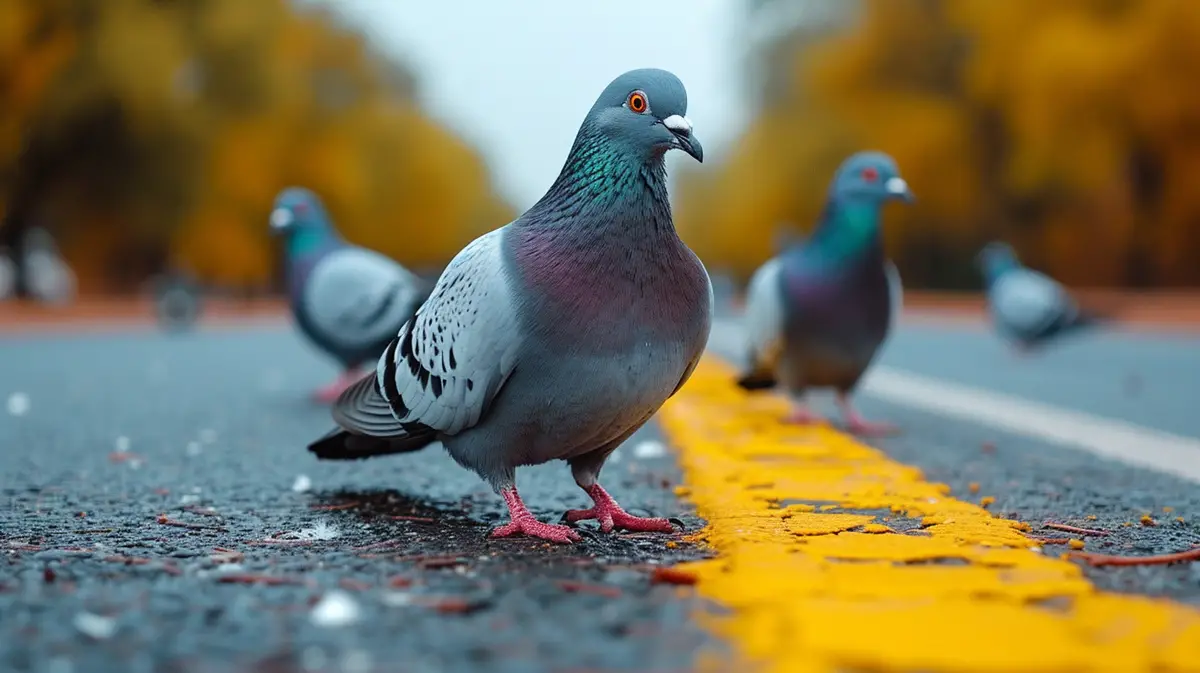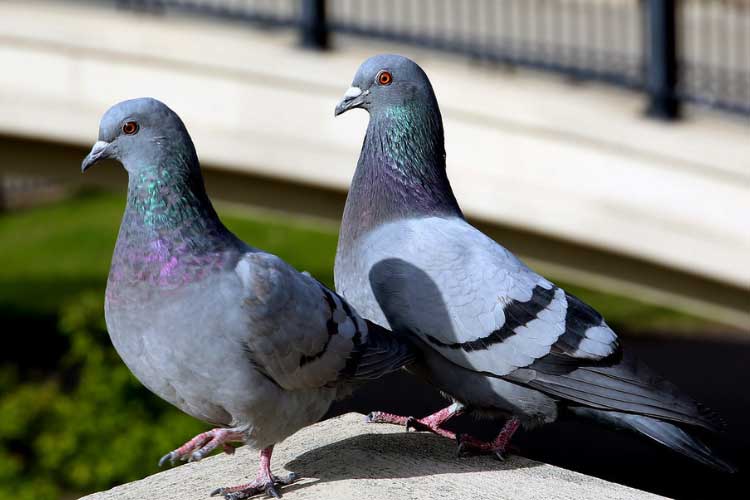20 Amazing Facts About Pigeons – Discover the Wonders
Hey there! I’m excited to share with you some mind-blowing facts about pigeons. These seemingly ordinary birds have a lot more to offer than meets the eye. So, buckle up and get ready to be amazed by these 20 incredible things you probably didn’t know about pigeons.
Did you know that pigeons have been used as messengers since ancient times? They have played a crucial role in delivering important messages across long distances. From carrying messages during wars to participating in sporting events, these birds have truly earned their reputation as reliable messengers.
But wait, there’s more! Pigeons also possess remarkable navigational skills. They can find their way home from unfamiliar locations, even if they are hundreds of miles away. How do they do it? Well, it’s all thanks to their ability to detect Earth’s magnetic fields. Fascinating, right?
The Historical Importance of Pigeons as Messengers
Throughout history, pigeons have played a vital role in delivering important messages. Let’s dive into some fascinating facts about the historical importance of pigeons as messengers.
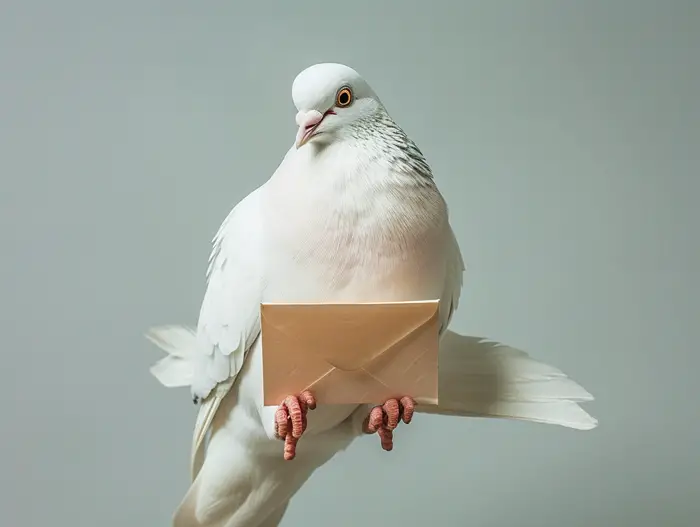
1. Long in Use
Pigeons have been used as messengers since ancient times, with records dating back thousands of years.
2. Ancient Civilizations
Civilizations like the Mesopotamians, Egyptians, and Persians employed pigeons to carry messages across vast territories.
3. World Wars
Pigeons’ messenger capabilities were even utilized during World Wars I and II. They were trusted to deliver critical information on the battlefield.
4. Reliable and Swift
Pigeons were valued for their reliability and speed in message delivery, even in challenging conditions or enemy territory.
5. Pigeon Posts
Many cultures established “pigeon posts” for efficient communication. These were networks of pigeon lofts strategically placed to cover long distances.
6. Famous Messengers
Some pigeons gained fame for their heroic efforts as messengers, like the famous Cher Ami, who saved a battalion during World War I.
7. Medal-Worthy Pigeons
During wartime, brave messenger pigeons were awarded medals for their contributions. Their valor and dedication were recognized.
8. Secret Codes
To protect messages, special codes were used, making it difficult for enemies to decipher the content carried by the pigeons.
9. Postage Stamps
Pigeons’ role in communication was so significant that several countries have even issued postage stamps featuring these winged messengers.
10. Decline of Pigeon Messaging
With advancements in technology, pigeon messaging gradually declined. However, their historical significance remains.
Pigeons’ Navigation Abilities: How They Find Their Way Home
Pigeons are known for their incredible navigation abilities, which allow them to find their way home from long distances. As someone who has studied and observed these fascinating birds, I am amazed by the strategies they employ to navigate and return to their roosting spots. Allow me to share with you some of the most incredible facts about pigeons’ navigation abilities.

1. Magnetic Sensitivity: Pigeons possess a unique ability to detect the Earth’s magnetic field. They have iron-rich cells in their beaks that act as a built-in compass, allowing them to navigate in the right direction.
2. Sun Orientation: Pigeons also rely on the position of the sun to orient themselves when flying. By using the sun’s position in relation to their internal compass, they can determine the correct direction and stay on track.
3. Visual Landmarks: Pigeons have a remarkable memory for visual landmarks. They can create mental maps of their surroundings, allowing them to navigate familiar routes with ease. They rely on familiar landmarks such as tall buildings, rivers, or distinctive structures as a guide.
4. Sense of Smell: Pigeons have a keen sense of smell, which helps them recognize the odors associated with their home and breeding sites. By using their sense of smell, they can locate their roosting spots, even in unfamiliar areas.
5. Inherited Knowledge: Pigeons inherit knowledge about their home location from their parents. Parent birds teach their young the routes and landmarks, ensuring that the next generation can find their way back home.
6. Homing Instinct: The ability of pigeons to find their way home is an innate instinct. They are born with the natural desire to return to their nest or roosting spot, which drives them to navigate over long distances.
7. Speed and Efficiency: Pigeons can cover impressive distances at incredible speeds. They are capable of flying up to 60 miles per hour (97 km/h) and can fly for several hours without getting tired. This fast and efficient flight helps them reach their destination quickly.
8. Accuracy: Pigeons can navigate with remarkable precision. Studies have shown that they can return to their exact roosting spot, even if it is hidden from view or in a crowded area.
9. Long-Distance Navigation: Pigeons are not limited to short distances.
Pigeon Racing: A Competitive Sport Involving these Birds
Pigeon racing is a thrilling and competitive sport that involves these incredible birds. It has been around for centuries and continues to captivate enthusiasts worldwide. In this section, I’ll delve into the fascinating world of pigeon racing and uncover some amazing facts about this beloved sport.

1. A Test of Speed and Navigation Skills
Pigeon racing is a test of both speed and navigation skills. The birds are released from a specific location, and the goal is for them to return to their respective lofts as quickly as possible. It’s a race against time, with pigeons flying long distances to reach their destination.
2. Homing Instinct: A Key Factor
A pigeon’s innate homing instinct plays a crucial role in pigeon racing. These birds possess an incredible ability to find their way back home, no matter where they are released. Scientists believe that pigeons use a combination of factors such as magnetic fields, visual landmarks, and their sense of smell to navigate their way back.
3. Training and Conditioning
Pigeon racing requires careful training and conditioning. Before participating in races, pigeons undergo a training regimen that includes regular exercise, strengthening their flight muscles, and building endurance. Trainers also ensure that the birds are in optimal health and nutrition to maximize their performance.
4. Electronic Timing Systems
To keep track of the birds’ arrival times, electronic timing systems are used in pigeon racing. These systems consist of small NFC (near-field communication) chips attached to the pigeons’ legs and electronic devices placed in their lofts. When a pigeon returns home, it activates the device, recording its arrival time accurately.
5. International Competitions and Prizes
Pigeon racing is not limited to a specific region or country. There are international competitions where fanciers from different parts of the world come together to showcase their pigeons’ racing prowess. These events offer substantial prize money, trophies, and prestige to the winners, making it a truly global sport.
6. Fancier Communities and Clubs
Pigeon racing has a vibrant community with dedicated fanciers and clubs. Fanciers are passionate about breeding, training, and racing pigeons, and they often form clubs to share their knowledge and experiences. These communities provide support, camaraderie, and a platform for enthusiasts to connect and compete.
Pigeon Intelligence: Surprising Discoveries about their Cognitive Abilities

When it comes to intelligence, pigeons might not be the first animal that comes to mind. However, these birds have some truly remarkable cognitive abilities that have astounded scientists. Let’s delve into the surprising discoveries about the intelligence of pigeons:
- Pattern Recognition: Pigeons are skilled at recognizing patterns, even in complex visual displays. They can identify shapes, colors, and even letters.
- Numerical Abilities: Believe it or not, pigeons can understand numerical concepts. They have been trained to recognize and differentiate between different quantities.
- Memory: Pigeons have excellent memory skills. They can remember specific landmarks and locations, which is crucial for their navigation abilities.
- Problem Solving: Pigeons are surprisingly adept at solving problems. They can figure out how to access hidden food sources by utilizing their reasoning skills.
- Self-Recognition: Pigeons have shown evidence of self-recognition, a trait that is often associated with highly intelligent animals. They can recognize their own reflection in a mirror.
- Emotional Intelligence: Pigeons have demonstrated the ability to understand and respond to emotions in both humans and other pigeons.
- Tool Use: Pigeons have been observed using tools to solve problems. They can pick up and manipulate objects to reach their goal.
- Time Perception: Pigeons have a remarkable sense of time. They can estimate the duration of time intervals and adjust their behavior accordingly.
- Communication: Pigeons have a complex communication system that involves cooing, posturing, and even dancing. They can convey messages to each other effectively.
- Adaptability: Pigeons are highly adaptable creatures. They can quickly learn and adjust to new environments and situations.
These incredible discoveries about pigeon intelligence have shed new light on the capabilities of these birds. Their cognitive abilities extend beyond what we initially thought, making them truly fascinating creatures to study.
So, the next time you see a pigeon while walking down the street, take a moment to appreciate the remarkable intelligence that lies behind their everyday behaviors. There is so much more to these feathered friends than meets the eye.
The Different Breeds of Pigeons and their Unique Characteristics
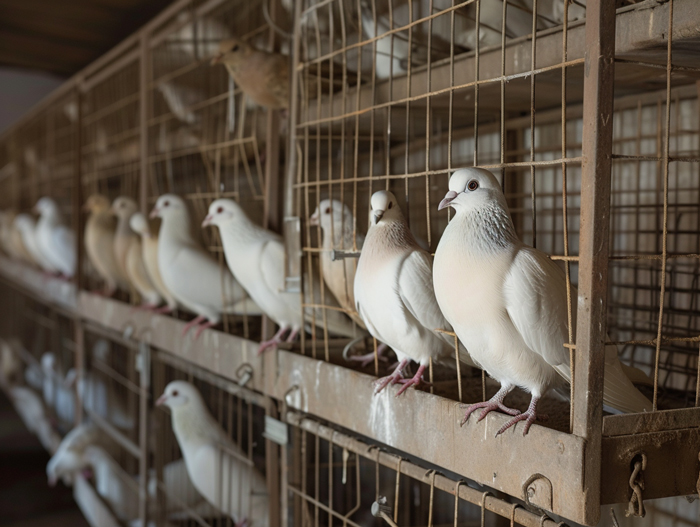
When it comes to pigeons, there is a wide variety of breeds, each with its own unique characteristics and traits. Let me take a moment to introduce you to some of the most fascinating pigeon breeds out there.
1. Homing Pigeons: These are the star navigators of the pigeon world. With their remarkable homing instinct, they can find their way back to their lofts from incredible distances.
2. Racing Pigeons: Built for speed, racing pigeons are known for their endurance and agility. They are meticulously trained and conditioned for competitive pigeon racing events.
3. Fancy Pigeons: Fancy pigeons come in a stunning array of colors and feather patterns. They are bred for their beauty and often showcased in pigeon shows.
4. Carrier Pigeons: Carrier pigeons were once widely used as messengers. They have an extraordinary ability to fly long distances at impressive speeds.
5. Tumbler Pigeons: Tumbler pigeons are known for their acrobatic skills. They perform amazing aerial somersaults and loops while flying.
6. Pouter Pigeons: With their distinctive bulging chests and inflated crop, pouter pigeons are known for their unique postures and displays.
7. Fantail Pigeons: Fantail pigeons have an impressive fan-shaped tail that spreads out gracefully when they strut around.
8. Jacobin Pigeons: Jacobin pigeons have an elaborately feathered neck that forms an impressive ruff. They are named after the Jacobin monks known for their ample attire.
9. Trumpeter Pigeons: These pigeons produce a melodious cooing sound that resembles a trumpet. They are celebrated for their vocal talents.
10. English Trumpeter Pigeons: The English Trumpeter Pigeons are a specific breed of Trumpeter pigeons with distinct features and a refined cooing voice.
From skilled navigators to elegant performers, each pigeon breed has its own special qualities that make them truly remarkable. Whether it’s the impressive speed and endurance of racing pigeons, the captivating beauty of fancy pigeons, or the unique postures and displays of pouter pigeons, there is something fascinating about every breed.
Stay with me as I delve deeper into more amazing facts and discoveries about these remarkable creatures.
Pigeon Bonding and Pairing: The Fascinating Nature of their Relationships

Let’s dive into the captivating world of pigeon bonding and pairing, where these birds showcase their remarkable relationships. Pigeons are known for their strong social bonds and the formation of lifelong partnerships. Here are some fascinating insights into their unique nature:
- Monogamous Mates: Pigeons are monogamous, meaning they form long-term partnerships with a single mate. Once they find their special someone, they stick together through thick and thin.
- Preening Rituals: Pigeons strengthen their bond through mutual preening. This process involves meticulously cleaning each other’s feathers, promoting trust, and reinforcing their emotional connection.
- Nest Building: Pigeons work together to build nests, demonstrating their cooperation and shared responsibilities. They gather twigs, leaves, and other materials to create a safe and comfortable space for their future offspring.
- Egg Incubation: Both male and female pigeons take turns incubating their eggs. This shared duty showcases their commitment to their offspring’s well-being and reflects the importance of partnership in their lives.
- Parental Care: Pigeon pairs share the responsibilities of raising their chicks. From feeding them a special pigeon milk produced in their crop to teaching them independence, both parents actively participate in nurturing the next generation.
- Pigeon Courtship: Pigeons engage in elaborate courtship displays to attract their mate. They may strut, coo, and puff up their feathers to capture their partner’s attention, showcasing their love through dance-like movements.
- Cooing Communication: Pigeons communicate with each other using a melodic cooing sound. Their coos serve multiple purposes, from displaying affection to marking their territory and strengthening their bond.
- Life-Long Pairings: Once pigeons find their perfect match, they often stay together for life. This enduring commitment enhances their reproductive success and ensures lasting companionship.
These amazing facts shed light on the complex and dedicated relationships that pigeons form. Their strong bonds, shared responsibilities, and lifelong partnerships make them truly remarkable creatures.
Stay tuned for more intriguing insights into the astonishing world of pigeons in our upcoming sections.
The Diet of Pigeons: Surprising Details about their Food Preferences
When it comes to food, pigeons are quite versatile and have unique dietary preferences. Let me share with you some interesting details about what these remarkable birds like to eat.

1. Seed Eaters: Pigeons are primarily seed eaters, with their diet consisting mainly of grains, such as wheat, barley, and corn.
2. Grain Lovers: They have a particular fondness for grains, and you might often spot them pecking around in fields or scavenging for spilled grains near farms.
3. Vegetarian Birds: Pigeons are vegetarian and do not consume meat or any kind of animal protein. They rely on plant-based foods for their nourishment.
4. Leafy Greens: Apart from grains, pigeons also enjoy feasting on leafy greens and vegetables, such as lettuce, spinach, and peas. These nutrient-rich foods help to keep them healthy.
5. Fruits and Berries: Pigeons have a sweet tooth too! They relish fruits and berries like apples, berries, and cherries, especially during the summer months when these treats are plentiful.
6. Urban Opportunists: Pigeons have adapted well to city life and often take advantage of the abundance of human food. They are known to scavenge for bread crumbs, French fries, and other tidbits left behind by people enjoying outdoor meals.
7. Water for Thirst: Pigeons need water to stay hydrated, just like any other living creature. They look for water sources such as ponds, fountains, and puddles to drink from.
8. Grit for Digestion: Pigeons are unique in that they require grit for proper digestion. They consume small, hard particles like gravel or small stones, which help grind down their food in their gizzard.
9. Observant Eaters: Pigeons are cautious and observant eaters. They prefer to feed in groups, where one pigeon will keep a lookout for potential dangers while the others feed.
10. Wing-Walking Seed Eaters: You might have seen pigeons “wing-walking”—the adorable behavior where they walk with one wing extended, picking up seeds with their beaks. This technique allows them to gather food efficiently.
From their love for grains to their occasional indulgence in fruits and berries, pigeons have a diverse and adaptable diet.
Pigeon Life Span: How Long Do these Birds Typically Live?

When it comes to the life span of pigeons, it’s important to understand that there are different factors that can influence how long they typically live. Here are a few fascinating facts about the life span of these birds:
- Average Life Span: On average, pigeons can live anywhere from 3 to 5 years in the wild. However, with proper care and shelter, they can live up to 15 years or even longer in captivity.
- Environmental Factors: Pigeons living in urban areas tend to have shorter life spans compared to those in rural or suburban environments. This is because urban settings expose them to more pollution, predators, and the risk of accidents.
- Predator Threat: Pigeons face threats from predators such as hawks, falcons, and cats. Birds that live in areas with a higher predator population may have a shorter life span due to the constant risk of predation.
- Quality of Nutrition: A well-balanced diet is crucial for the overall health and longevity of pigeons. A diet that includes a variety of grains, leafy greens, fruits, and berries will contribute to their well-being and increase their life expectancy.
- Disease and Illness: Like any living creature, pigeons are susceptible to various diseases and illnesses. Common health concerns include avian pox, respiratory infections, and parasites. Regular veterinary care and a clean living environment can help prolong their lives.
- Individual Variations: Just like humans, pigeons have their own unique genetic makeup. Some individuals may have better immune systems or natural resilience, which allows them to live longer than others.
It’s important to note that these are general guidelines, and individual pigeons may deviate from them. Factors such as genetics, diet, environment, and overall health play significant roles in determining the life span of these incredible birds.
As we continue to explore the world of pigeons, it’s fascinating to learn about the factors that influence their life span. Understanding these aspects can help us appreciate their beauty and resilience even more.
Pigeon Communication: An Intricate System of Coos, Cooes, and Cooers
Pigeons may be known for their beautiful cooing sounds, but their communication goes much deeper than that. With a sophisticated system of coos, cooes, and cooers, these birds can convey a wide range of messages and understand each other’s intentions. Allow me to share with you some fascinating facts about pigeon communication.
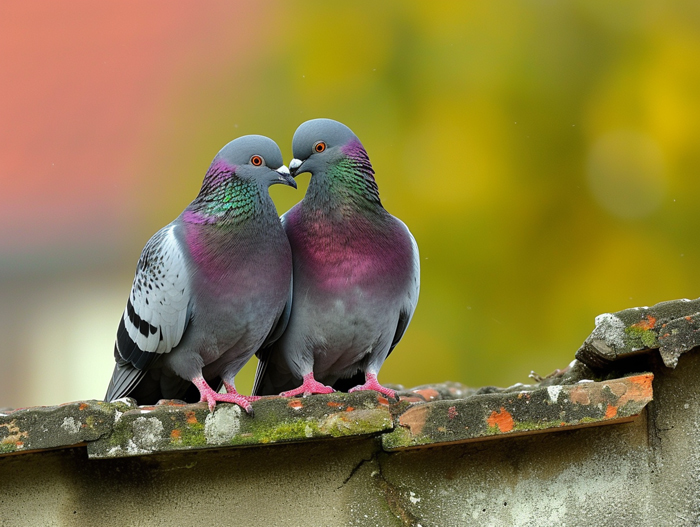
- Cooing Communication: Pigeons use their distinctive cooing sounds to communicate with each other. These coos can vary in pitch, rhythm, and duration, conveying different meanings and emotions.
- Courtship Displays: Male pigeons engage in elaborate courtship displays to attract a mate. They puff up their chests, bow their heads, and coo softly to impress their potential partners.
- Preening Rituals: Pigeons show affection and strengthen their bonds through preening rituals. They take turns cleaning and grooming each other’s feathers, displaying trust and intimacy.
- Body Language: Pigeons also use body language to communicate. They fluff up their feathers when feeling threatened or agitated, while relaxed pigeons will sit in an upright position, showing their contentment.
- Head Movements: The way pigeons move their heads can convey different messages. They may bob their heads rapidly during courtship or display a side-to-side head movement to establish dominance.
- Wing Clapping: In moments of excitement or exhilaration, pigeons may perform a behavior called wing clapping. They rapidly clap their wings together, creating a distinct sound that can indicate their enthusiasm.
- Feather Displays: Pigeons can raise or lower specific feathers on their bodies as a form of communication. They may raise the feathers on their necks to appear larger and more threatening or lower their feathers to show submission.
- Visual Cues: Pigeons communicate through visual cues as well. They use their bright, colorful plumage to signal their presence and intentions to other pigeons in their flock.
- Cooing Duets: Pigeon pairs engage in cooing duets, where they take turns cooing back and forth. This vocal cooperation strengthens their bond and reinforces their commitment to each other.
Pigeon Colors and Plumage: Understanding the Beautiful Patterns
When it comes to pigeons, one cannot help but marvel at the array of colors and patterns that adorn their feathers. Here’s a closer look at the fascinating world of pigeon colors and plumage:

- Diversity in Colors: Pigeons come in a wide range of colors, including white, gray, brown, black, and even shades of blue, green, and red. Their feathers can sometimes exhibit a captivating metallic sheen.
- Pattern Variations: Along with their vibrant colors, pigeons showcase various patterns on their feathers. Some popular patterns include splashes, bars, caps, and checkers. Each pigeon’s feathers offer a unique design.
- Influence of Genetics: The combinations of colors and patterns in pigeons are influenced by their genetic makeup. Breeders often work on creating different color combinations and patterns through selective breeding.
- Color Symbolism: In some cultures, certain pigeon colors hold symbolic meanings. For example, white pigeons are often associated with peace and purity, while black pigeons can be seen as mysterious or rare.
- Camouflage Advantage: Pigeons’ colors and patterns also play a role in their survival. The natural blending of their feathers with the environment helps them stay hidden from predators and potential threats.
- Feather Health: A pigeon’s plumage reflects its overall health and well-being. Shiny, vibrant feathers indicate good nutrition and a healthy lifestyle.
- Seasonal Changes: Pigeons may experience changes in their feathers based on the time of year. Some pigeons molt, or shed old feathers, before growing new ones. This process can slightly alter their colors and patterns.
- Urban Adaptation: Urban pigeons, often referred to as “city pigeons,” may exhibit different colors and patterns compared to their rural counterparts. This adaptability allows them to blend in with their concrete surroundings.
- Color Perception: Pigeons have excellent color vision. They can distinguish between a wide range of colors, which helps them navigate their surroundings and recognize potential mates.
- Feather Care: Pigeons take great pride in grooming and maintaining their feathers. They often use their beaks to preen and align each feather, ensuring they stay clean and well-kept.
Pigeon Health and Common Diseases: An Overview for Pigeon Enthusiasts
When it comes to pigeon health, it’s important for pigeon enthusiasts to be aware of common diseases and how to keep their feathered friends in optimal condition. In this section, I’ll provide an overview of some key aspects of pigeon health and common diseases that pigeon enthusiasts should be familiar with.
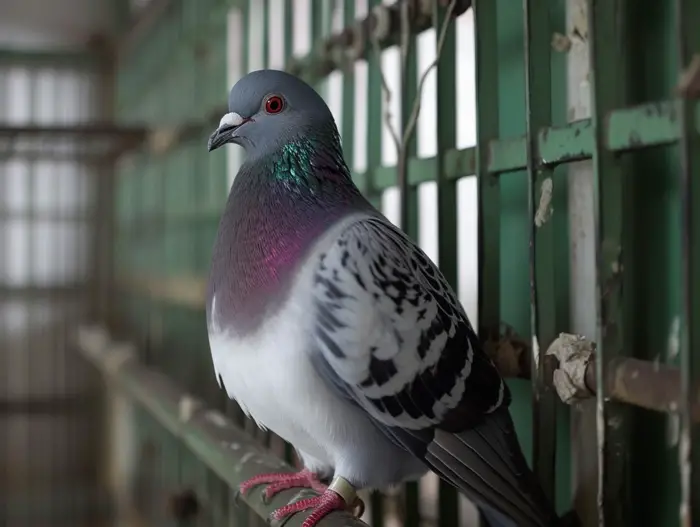
1. Pigeon Health Care
Taking care of a pigeon involves several essential aspects. Here are some key points to keep in mind:
- Nutrition: A balanced diet is crucial for maintaining pigeon health. Provide a mix of high-quality pigeon seed, grains, legumes, and fresh fruits and vegetables.
- Hygiene: Cleanliness is vital to prevent the spread of diseases. Regularly clean and disinfect the pigeon loft, food and water containers, and perches.
- Grooming: Pigeons are meticulous groomers. Regularly check their feathers for any signs of parasites or abnormalities, and ensure that their nails are trimmed to avoid injury.
- Exercise: Pigeons need regular exercise to stay healthy. Let them have free flight for a few hours each day or set up a spacious aviary for them to stretch their wings.
2. Common Pigeon Diseases
Unfortunately, pigeons are susceptible to various diseases. Here are some common ones to be aware of:
- Pigeon Paramyxovirus: This viral disease affects the central nervous system of pigeons, causing respiratory distress, neurological symptoms, and high mortality rates. Vaccination is crucial to prevent its spread.
- Canker: Also known as trichomoniasis, canker is a protozoal infection that affects the throat and digestive system of pigeons. Symptoms include yellowish plaques in the mouth, regurgitation, and weight loss. Medications can help treat and prevent this disease.
- Respiratory Infections: Pigeons are prone to respiratory infections, such as pigeon respiratory syndrome and ornithosis. These infections can cause symptoms like coughing, sneezing, nasal discharge, and reduced appetite. Prompt veterinary care and good hygiene practices are essential to prevent their spread.
- Parasites: Pigeons can be affected by external parasites like lice, mites, and ticks, as well as internal parasites like worms. Regularly inspect your pigeons for signs of infestation and treat them with appropriate medications.
Pigeon Homing: The Phenomenon of these Birds Returning Home
Did you know that pigeons have an incredible ability to find their way back home? It’s a fascinating phenomenon that has amazed scientists and bird enthusiasts for centuries. In this section, I’ll delve into the remarkable homing instincts of pigeons and the factors that contribute to their impressive navigational skills.

1. Homing Instinct: Pigeons possess a natural homing ability, allowing them to navigate across long distances and return to their original location. This instinct is thought to be a combination of genetics, environment, and learned behavior.
2. Magnetic Sensitivity: Pigeons can sense the Earth’s magnetic fields, which helps them orient themselves and navigate. They have iron-containing cells in their beaks that may act as a magnetic sensor, providing them with a “magnetic map” to guide them home.
3. Visual Landmarks: Pigeons rely on visual cues to navigate. They remember prominent landmarks, such as buildings, bodies of water, and mountains, which serve as reference points during their journeys. These visual cues help them create an internal map of their surroundings.
4. Sun and Celestial Navigation: Pigeons also use the position of the sun and stars to navigate. They can sense the angle of sunlight and the polarization of light, allowing them to determine their direction. Even on overcast days, pigeons can use subtle changes in the light’s polarization to guide them.
5. Familiarity and Experience: Pigeons have an excellent ability to memorize routes and recognize familiar areas. They rely on their previous experiences and the knowledge gained from repetitive flights to find their way back home.
6. Speed and Navigation: Pigeons can maintain an impressive average speed of 50 miles per hour. This allows them to cover long distances in a relatively short amount of time, enhancing their chances of returning to their home loft.
7. Genetics: Pigeons that excel in homing abilities are often bred selectively, passing on their superior genes to future generations. This has led to the development of homing pigeon breeds that are renowned for their exceptional navigational skills.
Pigeons as Symbols in Mythology and Culture: Historical Significance
Pigeons have held significant symbolism and cultural importance throughout history. Let’s explore some fascinating facts about how pigeons have been perceived and represented in various mythologies and cultures around the world.
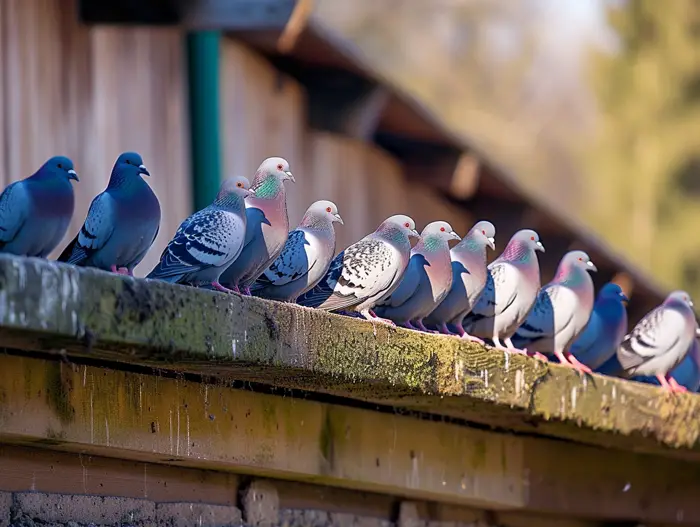
1. Symbol of Peace and Love
- Pigeons have long been associated with peace and love. In ancient Greece, they were seen as messengers of the goddess of love, Aphrodite. Their gentle cooing and graceful flight became symbols of harmony and affection.
2. Divine Messengers
- Many ancient civilizations believed that pigeons served as messengers between humans and the gods. In Hindu mythology, the divine bird Garuda, often depicted as a half-human, half-eagle creature, carried messages between the gods and humans.
3. Omens and Prophecies
- Pigeons were also believed to bring important omens and prophecies. In ancient Rome, priests known as “augurs” observed the behavior of birds, including pigeons, to predict future events. A pigeon’s flight patterns and behavior were thought to reveal divine messages and offer guidance.
4. Symbol of Freedom and Resilience
- Pigeons have been associated with freedom and resilience throughout history. During times of war, they were used as carriers to transmit crucial messages across enemy lines. Their remarkable ability to navigate and return home made them symbols of determination and strength.
5. Cultural Significance
- Pigeons have played significant roles in various cultures. In Chinese culture, the pigeon is a symbol of peace and good luck. In Native American culture, pigeons are revered as symbols of fertility and abundance. Their adaptability and resourcefulness have made them symbols of survival and adaptability in many cultures.
6. Artistic Depictions
- Pigeons have been depicted in art throughout the ages. Paintings, sculptures, and even mosaic art have featured the graceful beauty of pigeons. From ancient Egyptian hieroglyphs to Renaissance paintings, pigeons have captured the imagination of artists, further cementing their cultural significance.
7. Carrier Pigeon Heroes
- During World War I and World War II, carrier pigeons played a crucial role in delivering messages across battlefields. Their extraordinary ability to navigate through harsh conditions and enemy territory saved countless lives, earning them the admiration and respect of soldiers and civilians alike.
The Remarkable Parenting Skills of Pigeons: Nurturing their Chicks
As a passionate observer of pigeon behavior, I am constantly amazed by the remarkable parenting skills of these incredible birds. Pigeons exhibit a level of dedication and care for their chicks that is truly admirable. Let’s delve into some fascinating facts about how pigeons nurture their offspring.

1. Pigeons are monogamous: Once pigeons find their lifelong partner, they remain committed and devoted. Both parents play an active role in raising their chicks, ensuring their well-being and safety.
2. Pigeons build intricate nests: Pigeons take great care in constructing their nests, using a variety of materials such as twigs, grass, and even scraps of paper or fabric. Their nests are meticulously built to provide a comfortable and protected environment for their growing family.
3. Both parents share incubation duties: Pigeons take turns incubating their eggs, effectively sharing the responsibility of keeping them warm until they hatch. This cooperative effort allows both parents to bond with their offspring even before they emerge into the world.
4. Pigeon milk: A unique form of nourishment: One fascinating aspect of pigeon parenting is their ability to produce a specialized milk called “pigeon milk.” This rich secretion is produced by both male and female pigeons and is regurgitated to feed their hungry chicks. It’s an incredible adaptation that ensures their chicks receive the essential nutrients they need to thrive.
5. Pigeon chicks grow rapidly: Thanks to the nourishment provided by pigeon milk, pigeon chicks grow at an astonishing rate. Within just a few weeks, they transform from helpless hatchlings to fully-feathered juveniles, ready to explore the world under the watchful eyes of their dedicated parents.
6. Pigeon parents teach their chicks: Pigeon parents take an active role in teaching their chicks important life skills. They demonstrate flying techniques, show them how to forage for food, and guide them in navigating their surroundings. Through this guidance, pigeon parents prepare their offspring for independent life.
7. Pigeon parents protect their chicks: Pigeons are fiercely protective of their chicks, going to great lengths to safeguard them from potential threats. Whether it’s warding off predators or chasing away intruders, pigeon parents prioritize the safety of their vulnerable young ones.
Pigeon Societies: How Flocks Organize Themselves for Survival
Let’s delve into the fascinating world of pigeon societies and how these birds come together to ensure their survival. Pigeons are highly social creatures and form flocks that can range in size from just a few birds to hundreds or even thousands. In these flocks, pigeons exhibit remarkable organizational skills that allow them to thrive in their environments.
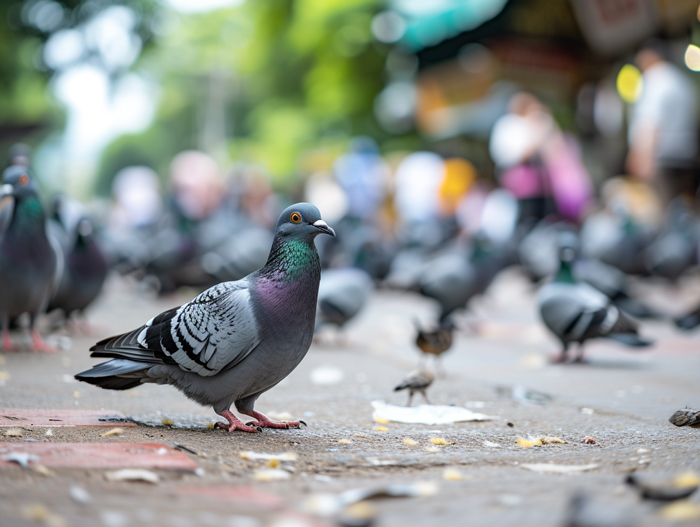
1. Hierarchical Structure: Pigeon flocks are not chaotic gatherings but rather have a hierarchical structure. Each flock has a well-defined pecking order, with dominant pigeons holding higher positions and exerting control over subordinate ones. This system helps maintain order and minimize conflicts.
2. Leadership Roles: Within the flock, certain pigeons take on leadership roles. These leaders guide the flock, making decisions on where to find food, water, and shelter. They also protect the flock from potential threats. Remarkably, these leadership roles can change over time as pigeons vie for dominance within the group.
3. Cooperation and Communication: Pigeons have a strong sense of cooperation and rely on effective communication to ensure the survival of the flock. They use a combination of vocalizations, body postures, and movements to convey messages and coordinate their actions. This helps them stay together and respond quickly to any changes in their environment.
4. Division of Labor: Pigeons also demonstrate a division of labor within their societies. While some birds may actively search for food, others act as sentinels, keeping watch for potential dangers. This distribution of tasks ensures that the flock can efficiently carry out necessary activities while minimizing the risks to individual birds.
5. Sharing of Resources: Pigeons in a flock often share resources such as food and nesting materials. This cooperative behavior ensures that all members of the flock have access to necessary resources for survival. Pigeons also engage in allopreening, where they groom each other’s feathers to maintain hygiene and strengthen social bonds.
6. Safety in Numbers: Being part of a larger group provides pigeons with better protection against predators. By flocking together, they can collectively watch out for threats and have a higher chance of evading predators compared to individual birds.
The Role of Pigeons in Scientific Research and Studying Animal Behavior
As an expert in the field, I have witnessed the remarkable role that pigeons play in scientific research and studying animal behavior. These intelligent birds have been instrumental in advancing our understanding of various scientific phenomena. Here are some fascinating facts about pigeons’ contribution to scientific research:
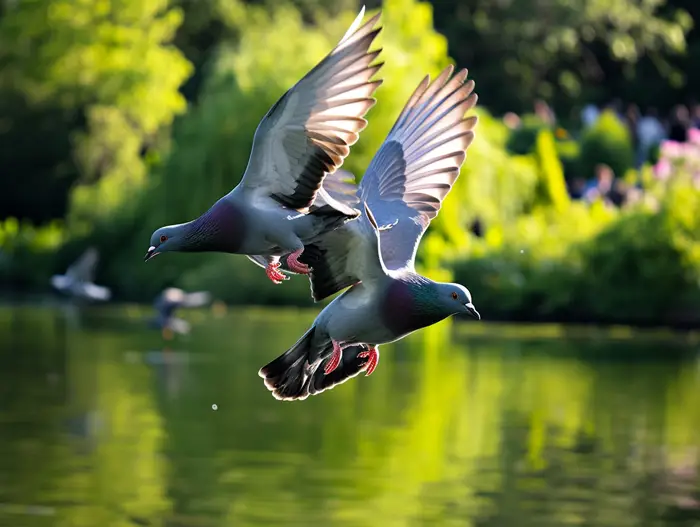
- Operant Conditioning: Pigeons have been extensively used in operant conditioning experiments, where they learn to associate certain behaviors with rewards. This technique has provided valuable insights into animal learning and behavior.
- Navigation Studies: Pigeons possess extraordinary navigational skills, which have been extensively studied. Researchers have explored how they use visual landmarks, magnetic fields, and celestial cues to find their way home. Studying pigeon navigation has shed light on the mechanisms behind animal orientation and navigation abilities.
- Memory and Cognitive Abilities: Pigeons have excellent memory and cognitive abilities, making them ideal subjects for studying learning and memory processes. They have been used in experiments to investigate concepts like pattern recognition, categorization, and numerical abilities.
- Social Behavior: Pigeons showcase complex social behaviors that have been of great interest to researchers. Their flocking behavior, dominance hierarchies, and communication patterns have provided insights into social dynamics in animal groups.
- Visual Perception: Pigeons have remarkable visual perception capabilities. They can discriminate between subtle differences in colors, shapes, and patterns. This makes them valuable subjects for studying visual perception and the neural mechanisms behind it.
- Drug Research: Pigeons have also been used to study the effects of drugs on behavior. Due to their physiology and ethological characteristics, pigeons serve as relevant models for investigating drug abuse, addiction, and other behavioral disorders.
- Comparative Studies: Pigeons belong to the avian class, which makes them an important species for comparative studies in animal behavior. By comparing their behaviors and cognitive abilities with those of other animals, researchers gain a more comprehensive understanding of different species’ evolutionary paths.
- Constraints on Research: It’s important to note that ethical considerations and animal welfare guidelines govern pigeon research, as with any other animal research. Researchers prioritize the welfare and well-being of the pigeons involved in their studies.
By studying pigeons, researchers have made significant strides in understanding animal behavior, cognition, and evolution. These birds continue to contribute to scientific research and help us uncover the mysteries of the animal kingdom.
Pigeon Adaptability: Thriving in Urban Environments
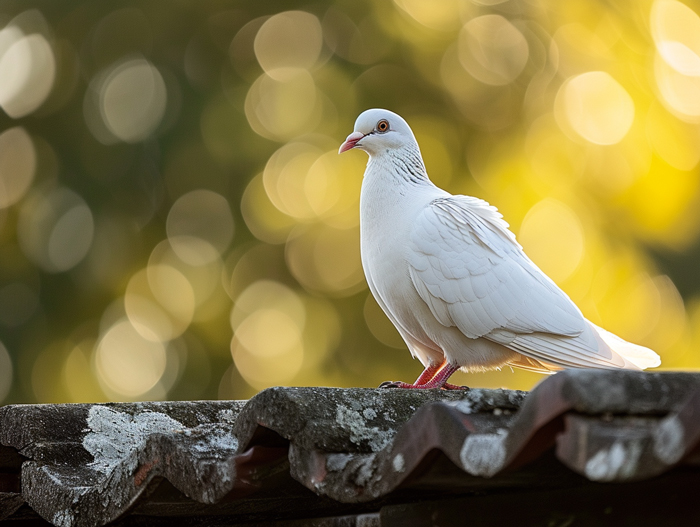
As an expert blogger on pigeons, I am fascinated by how these birds have adapted to thrive in urban environments. Pigeons, also known as rock doves, have proven to be highly adaptable creatures, making them well-suited to city life. Let’s explore some amazing facts about pigeon adaptability:
- Diverse Diet: Pigeons can survive on a wide variety of food sources, including grains, seeds, fruits, and even human scraps. Their ability to find sustenance in urban areas helps them thrive in city environments.
- Nesting Habits: Instead of building nests in trees, pigeons have adapted to create nests in the nooks and crannies of buildings and bridges. This resourcefulness allows them to find suitable habitat in cities.
- Rapid Reproduction: Pigeons have a high reproductive rate, with females capable of laying up to six eggs per brood. This adaptation enables them to quickly populate urban areas.
- Flight Adaptations: Pigeons have strong wings and remarkable flying skills, allowing them to navigate through cramped urban spaces and avoid obstacles such as buildings and vehicles.
- Navigational Abilities: Pigeons possess an extraordinary ability to navigate and find their way home, even in complex urban landscapes. They use visual landmarks, the sun, and magnetic fields to guide them back to their familiar urban roosts.
- Tolerance to Humans: Pigeons have developed a high tolerance to human presence, which allows them to live in close proximity to people. This adaptability makes them one of the most visible and familiar urban bird species.
- Urban Roosting Sites: Pigeons have adapted to utilize urban structures such as ledges, rooftops, and bridges as roosting sites, providing them with safe spaces to rest and observe their surroundings.
- Surviving Pollution: Despite the presence of pollutants in urban environments, pigeons have robust respiratory systems that allow them to withstand polluted air and thrive in cities.
- Social Structures: Pigeons have a strong social structure and form flocks, where they can share information about food sources and protect each other from predators. This social cohesion contributes to their successful adaptation in urban environments.
Pigeons as Sentinels of Environmental Health: Indicators of Pollution
As I delve deeper into the extraordinary world of pigeons, I cannot help but be amazed by their ability to serve as sentinels of environmental health. These remarkable birds have the uncanny knack for detecting and indicating the presence of pollution in our environment. Here are some fascinating facts about pigeons as indicators of pollution:

- Sensitivity to Air Quality: Pigeons possess incredibly sensitive respiratory systems, making them highly attuned to changes in air quality. When the air is polluted, pigeons are quick to react, exhibiting signs of discomfort and distress.
- Accurate Barometers: Pigeons have been used as barometers to measure pollution levels in various cities around the world. By studying the behavior and health of pigeons, researchers can gauge the impact of pollution on the surrounding environment.
- Bioaccumulation of Toxins: Pigeons have a habit of preening their feathers, which can lead to the accumulation of toxins from polluted air or contaminated surfaces. By analyzing the feathers of pigeons, scientists can identify the presence of heavy metals, pesticides, and other harmful substances.
- Urban vs. Rural Environments: Pigeons residing in urban areas tend to have higher levels of pollutant accumulation compared to their rural counterparts. This stark contrast serves as an important indicator of the impact of human activities on the environment.
- Pollution Hotspots: Pigeons have been found to congregate in areas with high levels of pollution, inadvertently highlighting the presence of pollution hotspots. These areas can then be targeted for further investigation and remedial actions.
- Correlation with Human Health: As pigeons are exposed to the same environmental pollutants as humans, studying their response to pollution can provide valuable insights into potential health risks faced by individuals living in polluted areas.
- Long-term Monitoring: Pigeons can serve as reliable long-term monitors of environmental pollution. Their ability to survive and reproduce in polluted environments allows for continuous and ongoing monitoring of the effects of pollution over extended periods.
These remarkable birds truly exemplify the concept of being our feathered friends and guardians of the environment. By paying attention to their behavior and health, we can better understand the impact of pollution on our ecosystems and take necessary steps to mitigate its effects.
Pigeon Myths Debunked: Dispelling Misconceptions about these Birds
Contrary to popular belief, pigeons are often misunderstood and their reputation tends to suffer from misconceptions. Let’s take a closer look at these remarkable birds and debunk some of the myths surrounding them.

- Pigeons are dirty and carry diseases. While it’s true that pigeons can contribute to soiling public spaces, they don’t carry any more diseases than other birds or animals. It’s important to note that the dirtiness associated with pigeons is usually due to human interaction and not a characteristic of the birds themselves.
- Pigeons are pests. Pigeons have adapted to urban environments and have become a familiar sight in cities around the world. However, they are not pests in the true sense of the word. They are simply trying to survive and make the most of available resources, just like any other species.
- Pigeons are dumb. On the contrary, pigeons are highly intelligent birds. They have been studied extensively and have shown remarkable cognitive abilities. Pigeons possess excellent memory, observational skills, and the ability to navigate over long distances, which is a testament to their intelligence.
- Pigeons are aggressive. Pigeons are generally peaceful birds and pose no threat to humans. Any perceived aggression is usually a result of the birds feeling threatened or seeking to protect their nests or offspring. With proper understanding and respect, interactions with pigeons can be peaceful and harmonious.
- Pigeons are carriers of bad luck. This belief is purely superstition and has no basis in reality. Pigeons, in fact, have been regarded as symbols of peace, love, and goodwill in many cultures throughout history.
- Pigeons are a nuisance. While some may find pigeons bothersome, it’s important to remember that they are an integral part of urban ecosystems. Their presence can bring joy to many people and they also serve as valuable sentinels of environmental health.
By debunking these myths, we can gain a greater appreciation for these fascinating birds and recognize the important role they play in our world. Pigeons are resilient, intelligent, and adaptable creatures that deserve our respect and understanding.
Conclusion
Pigeons are truly remarkable creatures that deserve our admiration and understanding. Throughout this article, we have explored the fascinating aspects of pigeon communication, colors and plumage, health and common diseases, homing abilities, cultural significance, parenting skills, societal behavior, scientific research, adaptability to urban environments, and their role as sentinels of environmental health.
Pigeons exhibit a complex system of communication, using various methods to convey messages and understand each other’s intentions. Their colors and plumage showcase the diversity and genetic influences that contribute to their beauty. Pigeons are also highly adaptable to urban environments, thriving due to their diverse diet, nesting habits, and navigational abilities.
Furthermore, pigeons play a significant role in scientific research, contributing to our understanding of animal behavior, cognition, and evolution. They have also been used as sentinels of environmental health, providing valuable insights into pollution levels in urban areas.
It is important to debunk common misconceptions about pigeons and recognize their intelligence, adaptability, and the important role they play in urban ecosystems. Pigeons are truly fascinating creatures that deserve our respect and appreciation.
